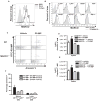Therapeutic inflammatory monocyte modulation using immune-modifying microparticles
- PMID: 24431111
- PMCID: PMC3973033
- DOI: 10.1126/scitranslmed.3007563
Therapeutic inflammatory monocyte modulation using immune-modifying microparticles
Abstract
Inflammatory monocyte-derived effector cells play an important role in the pathogenesis of numerous inflammatory diseases. However, no treatment option exists that is capable of modulating these cells specifically. We show that infused negatively charged, immune-modifying microparticles (IMPs), derived from polystyrene, microdiamonds, or biodegradable poly(lactic-co-glycolic) acid, were taken up by inflammatory monocytes, in an opsonin-independent fashion, via the macrophage receptor with collagenous structure (MARCO). Subsequently, these monocytes no longer trafficked to sites of inflammation; rather, IMP infusion caused their sequestration in the spleen through apoptotic cell clearance mechanisms and, ultimately, caspase-3-mediated apoptosis. Administration of IMPs in mouse models of myocardial infarction, experimental autoimmune encephalomyelitis, dextran sodium sulfate-induced colitis, thioglycollate-induced peritonitis, and lethal flavivirus encephalitis markedly reduced monocyte accumulation at inflammatory foci, reduced disease symptoms, and promoted tissue repair. Together, these data highlight the intricate interplay between scavenger receptors, the spleen, and inflammatory monocyte function and support the translation of IMPs for therapeutic use in diseases caused or potentiated by inflammatory monocytes.
Conflict of interest statement
Figures







Comment in
-
Inflammatory disorders: monocytes derailed by microparticles.Nat Rev Drug Discov. 2014 Mar;13(3):175. doi: 10.1038/nrd4263. Epub 2014 Feb 14. Nat Rev Drug Discov. 2014. PMID: 24525780 No abstract available.
Similar articles
-
Targeting inflammatory monocytes by immune-modifying nanoparticles prevents acute kidney allograft rejection.Kidney Int. 2022 Nov;102(5):1090-1102. doi: 10.1016/j.kint.2022.06.024. Epub 2022 Jul 16. Kidney Int. 2022. PMID: 35850291
-
S100A9 Links Inflammation and Repair in Myocardial Infarction.Circ Res. 2020 Aug 14;127(5):664-676. doi: 10.1161/CIRCRESAHA.120.315865. Epub 2020 May 21. Circ Res. 2020. PMID: 32434457
-
Biodegradable microspheres targeting mucosal immune-regulating cells: new approach for treatment of inflammatory bowel disease.J Gastroenterol. 2003 Mar;38 Suppl 15:59-62. J Gastroenterol. 2003. PMID: 12698874 Review.
-
Nanoparticle incorporating Toll-like receptor 4 inhibitor attenuates myocardial ischaemia-reperfusion injury by inhibiting monocyte-mediated inflammation in mice.Cardiovasc Res. 2019 Jun 1;115(7):1244-1255. doi: 10.1093/cvr/cvz066. Cardiovasc Res. 2019. PMID: 30851101
-
Inflammatory monocytes and the pathogenesis of viral encephalitis.J Neuroinflammation. 2012 Dec 17;9:270. doi: 10.1186/1742-2094-9-270. J Neuroinflammation. 2012. PMID: 23244217 Free PMC article. Review.
Cited by
-
Harnessing biomaterials to engineer the lymph node microenvironment for immunity or tolerance.AAPS J. 2015 Mar;17(2):323-38. doi: 10.1208/s12248-014-9708-2. Epub 2014 Dec 23. AAPS J. 2015. PMID: 25533221 Free PMC article. Review.
-
Monocytes and macrophages in tissue repair: Implications for immunoregenerative biomaterial design.Exp Biol Med (Maywood). 2016 May;241(10):1084-97. doi: 10.1177/1535370216650293. Exp Biol Med (Maywood). 2016. PMID: 27229903 Free PMC article. Review.
-
Differential roles of resident microglia and infiltrating monocytes in murine CNS autoimmunity.Semin Immunopathol. 2015 Nov;37(6):613-23. doi: 10.1007/s00281-015-0519-z. Epub 2015 Aug 4. Semin Immunopathol. 2015. PMID: 26240063 Review.
-
Inflammatory disorders: monocytes derailed by microparticles.Nat Rev Drug Discov. 2014 Mar;13(3):175. doi: 10.1038/nrd4263. Epub 2014 Feb 14. Nat Rev Drug Discov. 2014. PMID: 24525780 No abstract available.
-
Quantum dot therapeutics: a new class of radical therapies.J Biol Eng. 2019 May 29;13:48. doi: 10.1186/s13036-019-0173-4. eCollection 2019. J Biol Eng. 2019. PMID: 31160923 Free PMC article. Review.
References
-
- Bain CC, Scott CL, Uronen-Hansson H, Gudjonsson S, Jansson O, Grip O, Guilliams M, Malissen B, Agace WW, Mowat AM. Resident and pro-inflammatory macrophages in the colon represent alternative context-dependent fates of the same Ly6Chi monocyte precursors. Mucosal Immunol. 2013;6:498–510. - PMC - PubMed
Publication types
MeSH terms
Substances
Grants and funding
LinkOut - more resources
Full Text Sources
Other Literature Sources
Molecular Biology Databases
Research Materials
Miscellaneous

